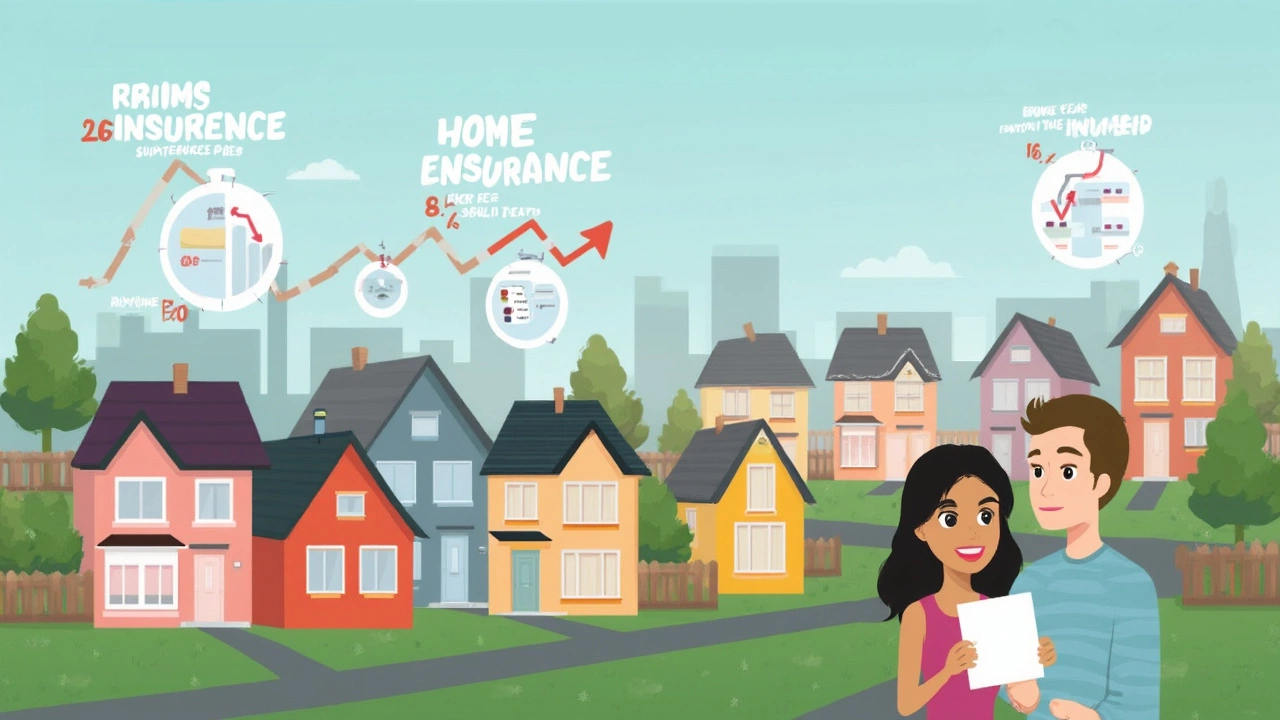Home Insurance Increase: Is It Normal Every Year?
 Jun, 6 2025
Jun, 6 2025
You rip open the renewal notice and yep—your home insurance bill jumped again. Doesn’t matter if you filed a claim or not. So, is this just the way it goes now? Spoiler: these hikes aren’t random. They actually follow some clear patterns and there's usually a real reason behind every increase.
Think about it—insurance companies are basically betting your house won’t need a fat payout this year. But when natural disasters like hurricanes or wildfires get worse, or when building materials skyrocket in price, those bets start looking riskier. That extra risk usually gets passed right to your bill, even if you haven’t done a thing wrong.
- Why Home Insurance Premiums Go Up
- How Much of an Increase Is Actually Normal?
- Ways to Lower Your Annual Insurance Bill
- Signals Your Rate Hike Isn’t Typical
Why Home Insurance Premiums Go Up
No one loves getting hit with a higher home insurance bill, but there’s real math behind it. Companies raise those rates for reasons that hit close to home (sometimes literally), and it mostly comes down to risk and replacement costs.
Here are some big drivers making your home insurance climb almost every year:
- More Extreme Weather: Hurricanes, floods, hail, wildfires—you name it, they’re happening more often and costing way more to clean up. According to the National Centers for Environmental Information, the U.S. had 28 disasters topping $1 billion each in damage in 2023. That’s a new record.
- Cost to Rebuild: Supply chain hiccups, labor shortages, and pricier materials like lumber jack up the repairs or rebuild cost for damaged homes. Insurers factor this into your bill, even if you don’t live in a tornado alley.
- Claims in Your Area: If there’s a string of break-ins, fires, or water damage claims nearby, everyone’s premiums usually go up—even if you never file a claim.
- Reinsurance: Insurance companies themselves buy protection called reinsurance. When that gets pricier because of global events, you’ll see it passed onto your bill.
Check out this quick comparison that shows why things get more expensive:
| Factor | 2015 Avg. | 2023 Avg. |
|---|---|---|
| Cost to Rebuild (Per Sq. Ft.) | $110 | $173 |
| U.S. Billion-Dollar Disasters | 10 | 28 |
| Average Premium | $1,173 | $1,428 |
So yeah, most of these price hikes aren’t because agents feel like messing with you. It’s the result of bigger, costlier risks right across the map. Knowing this helps you figure out what you can—and can’t—control about your own rates.
How Much of an Increase Is Actually Normal?
Wondering what’s “normal” for an annual bump? You’re not alone. Most years, homeowners see their premiums creep up by about 2% to 5% on average. It sounds small until you realize it stacks up, year after year. But here’s the thing: the exact jump depends a lot on what’s happening where you live and the wider insurance market.
Back in 2023, the Insurance Information Institute showed the national average premium increase was right around 4%. But some states, especially places wracked by hurricanes or wildfires (think Florida, Texas, and California), got hit with spikes way bigger—sometimes even double digits. Inflation also throws fuel on the fire. The cost to rebuild a home went up 24% since 2020 because materials and labor got pricey. Your policy tries to keep up just in case you need a total rebuild, so that cost trickles straight into your bill.
Take a look at these average increases over the past few years:
| Year | National Avg. Increase (%) |
|---|---|
| 2020 | 3.1 |
| 2021 | 3.5 |
| 2022 | 4.2 |
| 2023 | 4.0 |
| 2024 (Projected) | 5.5 |
If your home insurance bill jumps by 4-6%, you’re right in the “normal” range these days. But if you’re staring at a 15% hike and scratching your head, that’s worth digging into—there could be something wild happening factoring into your rates.
One way to tell if you’re paying too much is to compare your bill with your local average. Check with neighbors or run a free quote online using your ZIP code. If your number looks way out of line, it’s time to ask questions or maybe even shop around.

Ways to Lower Your Annual Insurance Bill
Home insurance doesn’t have to wipe out your wallet every year. If you’re careful and pay attention, you can knock that number down, sometimes by a lot. These aren’t pipe dreams—real people save hundreds just by making a few changes. Here’s how you can do it:
- Shop Around Yearly: Never just renew without checking what other companies offer. Rates can change fast, even for similar coverage. Getting three to five quotes once a year is worth your time.
- Raise Your Deductible: The higher your deductible (the amount you pay if something happens), the lower your bill. But don’t set it too high; make sure you can afford it if disaster hits.
- Bundle Policies: If your home and car insurance come from the same place, you often save 10%–25%. Just ask your provider for a bundle discount.
- Score Discounts: Companies hand out discounts for stuff like smoke detectors, burglar alarms, even being claim-free for a few years. Some give a deal just for switching from a competitor.
- Improve Home Security: Deadbolts, cameras, and smart-home devices not only keep you safe, they can push your premium down. Let your agent know what you’ve installed.
- Review Your Coverage: Outdated or duplicate coverage costs extra for no reason. Check that the stuff listed in your policy still makes sense—maybe you got rid of a shed, or no longer have pricey jewelry to insure.
- Don’t File Small Claims: The more claims you make, the higher your future bills. If you can handle a small repair, just do it and avoid the red flag.
Here’s a quick look at what kind of savings folks have actually reported, according to a 2024 study by J.D. Power:
| Way to Save | Average Annual Savings |
|---|---|
| Raising Deductible | $150–$350 |
| Bundling Policies | $200–$400 |
| Adding Home Security | $50–$150 |
| Annual Shopping | $100–$300 |
All these steps put you back in the driver’s seat. And here’s one more: always read the fine print. Some companies toss in fees or weird surcharges that don’t make sense. If you spot anything off, ask questions until you understand your home insurance bill inside out.
Signals Your Rate Hike Isn’t Typical
If your renewal notice smacks you with a way bigger increase than your friends or neighbors are seeing, something might be off. Not every jump in your home insurance bill is just "the market." Some red flags mean it’s time to dig deeper, so you don’t pay more than you should.
First things first: moderate increases of 2-10% in a year are common across the U.S. According to the National Association of Insurance Commissioners (NAIC), the average yearly home insurance bump was about 6% from 2022 to 2024. But if you’re staring at a 25% or even 40% jump (with no recent claim), that’s not business as usual.
| Year | Average Premium Increase (%) |
|---|---|
| 2022 | 4.8% |
| 2023 | 6.2% |
| 2024 | 6.0% |
So what are the not-so-normal signs?
- Your insurance company changes its formulas or rating system: Some carriers switch how they calculate risk, suddenly bumping up rates for certain zip codes or home types while others stay steady.
- Big jump with no explanation: It’s a red flag if there’s no note about claims, recent disasters, or inflation. Your insurer legally has to itemize certain surcharges. If the increase feels random, call and ask for a written breakdown.
- Your neighbors aren’t seeing the same hike: If your rates surge and the folks next door barely see a blip, your file could have a mistake, like the wrong square footage, an outdated roof age, or a false claim on your record. Always double-check your renewal statements for errors.
- Nonrenewal threats mixed with a large increase: Some companies hike rates to push high-risk policyholders away before straight-up dropping them. If you get a steep bump and a warning letter, it’s time to shop around fast.
- Your credit score took a hit: Many insurers use credit-based insurance scores now. If your score dropped—even for reasons unrelated to insurance—your premium can spike. Ask your agent if your credit score played a role.
Action step if you spot anything weird: get a second quote from a different insurer. Make sure all your details are correct, compare apples-to-apples coverage, and don’t just accept the first number. If your jump is out of line, challenge it. You’ve got options.
